In this article, we will review the migration steps of the Planner Basic (MS Planner) -> Planner Basic (MS Planner) migration scenario.
To launch the migration from Planner Basic to Planner Basic, you will need to take several steps:
Step 1 - Connect to source and target systems
To start the migration process, perform the following:
1. Open the Project Migrator home page and select the Planner (basic plans) -> Planner (basic plans) migration scenario. Alternatively, click on the Start Migration button.

2. If you click the Start New Migration button on the Home page, select the source system by clicking on the Please Select System button, and select Planner (basic plans).

3. Click on the 'Connect' button to connect to your Planner Basic account. If your Planner Basic system is in the Office 365 US Government service, check the 'I'm using Planner in GCC High environment' checkbox for Project Migrator to work with your tenant. Otherwise, leave this checkbox unchecked.

4. Provide your credentials and log in to Planner Basic using your Office 365 account. 
If you connect to Planner Basic for the first time, Global Administrator consent is required.
Before adding a connection for the first time, Office 365 tenant Global Administrator consent (Admin Consent) is required to grant Project Migrator app permissions to access Office 365. Admin Consent should be granted to Project Migrator only once. When the consent is granted by Global Admin, any other Planner Basic Account (that meets the requirements described in the 'Account requirements' article) can be used to add more connections within the same Office 365 tenant.
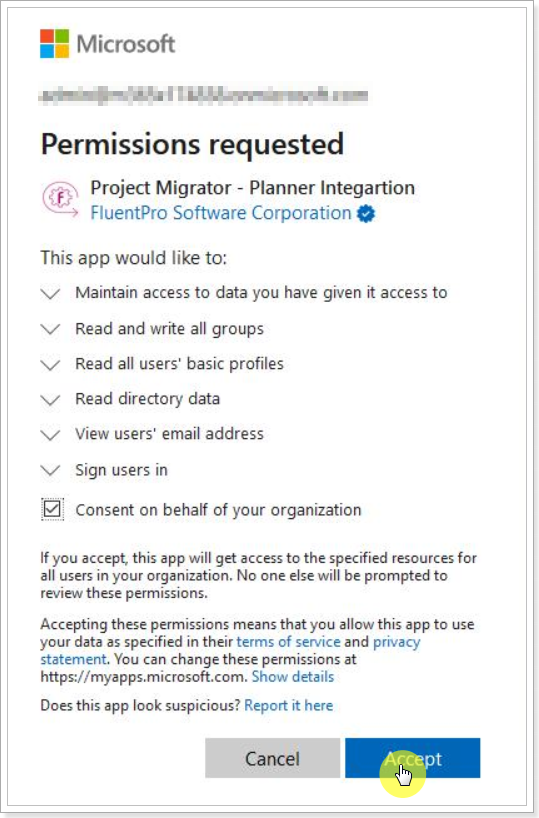
If you use an account that does not have Administrator permissions to add a Planner Basic connection for the first time, the 'Need Admin Approval' window will be opened instead. The 'Need Admin Approval' window may be opened after the login attempt. This window appears in case it is not allowed by your organization for users to add apps to the Office 365 tenant without admin approval.
In this case, contact your Planner application Global Administrator for Admin Consent, it is required to grant Project Migrator app permissions to access Office 365.
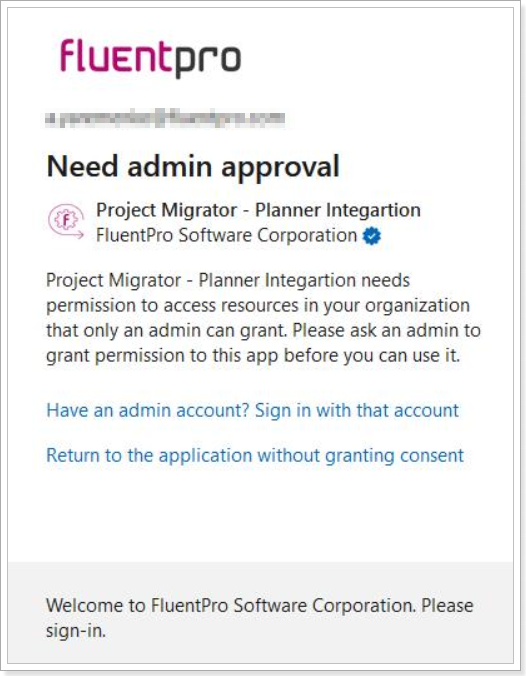
When the credentials are added, they are encrypted and stored for your convenience. The next time you need to launch the migration process, you can select from the list of credentials added before.
If you need to change the account you have provided, click on the Change button.

5. In the next step, connect the target system. Click the Please select system button and select Planner (basic plans).

6. Click on the 'Connect' button to connect to your Planner Basic account. Provide your credentials and log in to Planner Basic using your Office 365 account. If your Planner Basic system is in the Office 365 US Government service, check the 'I'm using Planner in GCC High environment' checkbox for Project Migrator to work with your tenant.
When the source and target systems are added and connected, you can proceed to the next step and select source data for migration.

Step 2 - Select source data
Project Migrator allows selecting all data for migration or only the required items from the list.
'All' option is selected by default. If you select the 'All' option, all Planner Plans where the source connection account is added as a member will be migrated.

'Selected' option allows migrating only the Plans which you select from the Available Plans list.
Click the 'Selected' button.

'Available plans' window will be opened. There are several fields on this page that you can use to filter the information out and make the selection faster.
Select the required plans from the list and click the 'Add Selected' button.

Please note: If you have not purchased any subscription plan yet, a free plan (for 2 projects) will be applied. If you have exceeded the limit of projects that you can select for migration according to your subscription plan (free or paid one), you can upgrade your plan from this page directly by clicking on the 'Upgrade to (number) of projects plan' button.
For more information, please refer to the 'Project Migrator Subscriptions' article.
When the items are selected you can proceed to the next step: Step 3: Object Mapping.
Step 3 - Object mapping
1. Migration settings
Microsoft 365 Group Creation Mode: In this section, you can select whether to create a separate group for each Plan, create groups with source group names and settings for the selected Plans, or create all Plans in one group (new or existing).
'Create groups using Plan names': if this option is selected, each plan will have a separate Microsoft 365 group created. The groups will be created with the same names as the Plans names in this case.
With this group creation mode, only users that are assigned to tasks in the migrated source Plan(s) will be added as members to the target Microsoft 365 group(s) on condition they are mapped with the corresponding target users.
Other members of the source group(s) and Plan(s) will not be added to the target M365 group(s). Also, the source group owners will not be added as owners to the target group(s).
The source group Privacy, settings and mail nickname will not be preserved for the target group with the 'Create groups using Plan names' group creation mode.
If a Group with the same name already exists in Planner, a new group will not be created. Project Migrator will find this group by name and will use it for migration (taking into account the setting below 'Create new or merge with existing Plans').

‘Create groups with source group names and settings’: that group creation mode allows migrating source Microsoft 365 groups for the selected Plans to the target tenant. Target groups will be created with the same names and mail nicknames as the source groups, and the source group Privacy and General Settings will be preserved.
If a Group with the same name already exists in Planner, a new group will not be created. Project Migrator will find this group by name and will use it for migration (taking into account the setting below 'Create new or merge with existing Plans').
Please note: If there is an existing group with the same name and mail nickname in the target tenant, but the connection account is not a member or an owner of that group, a new group will be created with a bit different mail nickname.
If the 'Create groups with source names and settings' option is selected, the migration will fail with an error that a new group with the already used mail nickname could not be created. The target migration account should be a member or an owner of that existing group to be able to migrate to it.
‘Migrate all source group members and owners’: this option is available for all group creation modes. If it is enabled, all source group owners and members will be added to the target group on the condition the corresponding users exist in the target tenant and are mapped correctly.
In case that option is not checked, only mapped users that are assigned to tasks in the migrated Plan(s) will be added as members to the corresponding Microsoft 365 groups in the target tenant. Other source group owners and members will not be added to the target groups. If new Microsoft 365 groups and Planner Plans are created during the migration, the target Planner migration account will be set as the group and Plan owner and member.

If the 'Create all Plans in one group' option is selected, then all Plans will be added to the same group during migration.
In the Group Name field, you can provide the name of an existing group or a new group name to create a new group during migration.
With this group creation mode, users who are assigned to tasks in all the migrated source Plan(s) will be added as members to one target Microsoft 365 group, on condition that they are mapped with the corresponding target users.
Other members of the source group(s) and Plan(s) will not be added to the target M365 group. Also, the source group owners will not be added as owners to the target group.
If a Group with the same name already exists in Planner, a new group will not be created. Project Migrator will find this group by name and will use it for migration (taking into account the setting below 'Create new or merge with existing Plans').
Please note: A Maximum of 200 Plans can be created in one Microsoft 365 group.
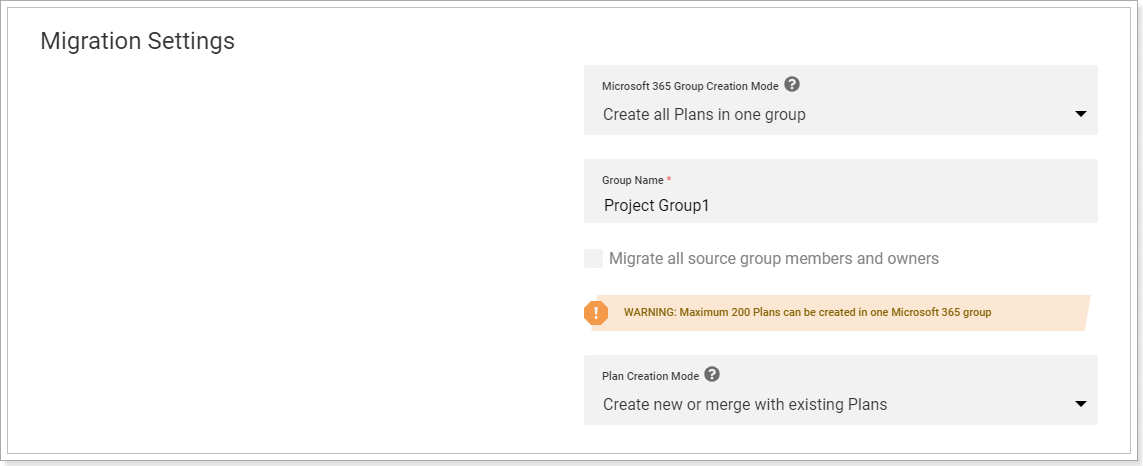
‘Migrate all source group members and owners’: this option is available for all the group creation modes. If it is enabled, all source group owners and members will be added to the target group on the condition the corresponding users exist in the target tenant and are mapped correctly.
In case that option is not checked, only mapped users that are assigned to tasks in the migrated Plan(s) will be added as members to the corresponding Microsoft 365 groups in the target tenant. Other source group owners and members will not be added to the target groups. If new Microsoft 365 groups and Planner Plans are created during the migration, the target Planner migration account will be set as the group and Plan owner and member.
Please note: If you are migrating the Plans to an existing Planner group (or to different groups but there is a group in Planner with the same name as the migrated Plan name) the migration Planner account that you have provided in the Target System section should be a member or an owner of that group in Planner.
Plan creation mode: In this section, you can select how plans should be created if there are Plans in Planner with the same names as Plans in the source system.
'Create new or merge with existing ones' option allows creating new Plans or merging the data to the existing Plans with the same names as the source Plans if any.
'Create new and remove existing Planes before creating' option allows creating new Plans from scratch deleting the existing ones with the same names as the source Plans if any. In this case, existing Planner Plans with names that match selected source Plan names will be removed together with all their tasks.
2. Mapping
2.1. Plan Field Mapping
In this section, you can review Plan field mapping. The Plan name corresponds to the Plan name, and the Bucket name to the Bucket name.

2.2. Task Field Mapping
This section is used to map task fields from the source Planner Basic to the target Planner Basic system.
In this section, you can review which fields are migrated from the source Planner Basic system to the target one. They are editable, and the fields can be deleted if needed (excluded from the migration).
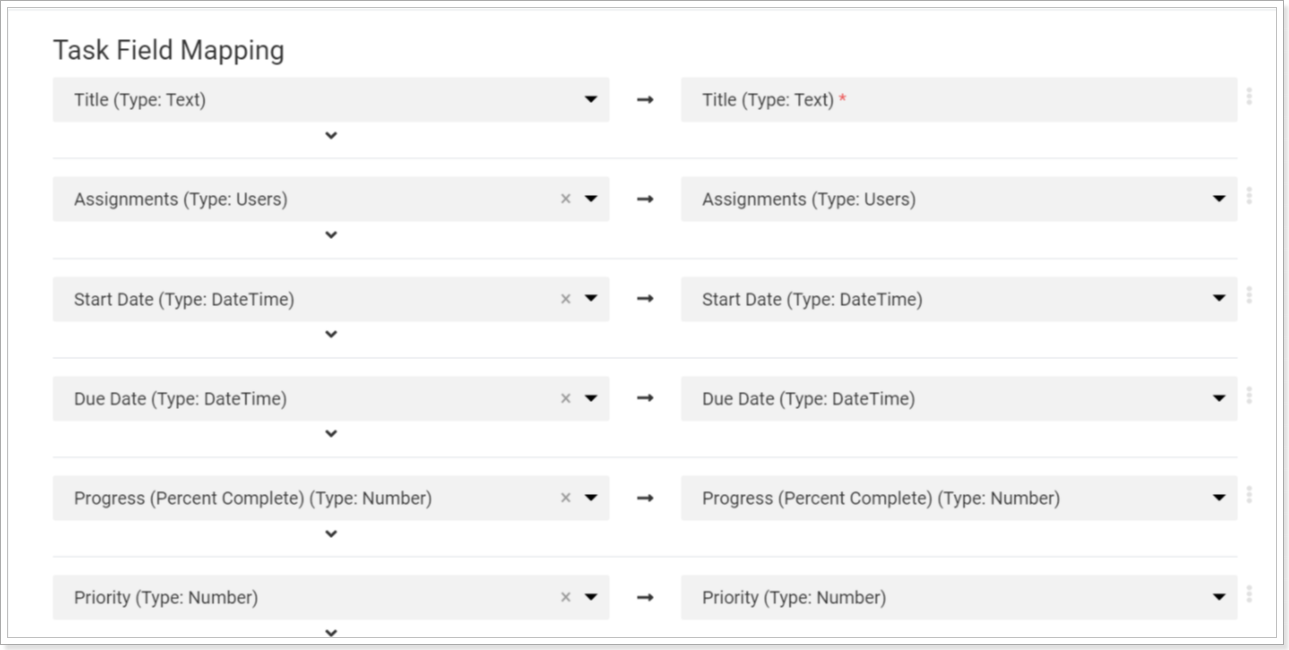
2.3. Users Mapping
This section is used to map the users from the source Planner Basic to the target Planner Basic system.
Please note: The users cannot be migrated from the source Planner Basic tenant to the target Planner Basic tenant. User accounts should already exist on the target environment (in the Entra ID (formerly Azure AD) of your Planner Basic tenant) before the migration starts. In this case, Project Migrator will find the required users by their accounts and will map them automatically to migrate the assignments and other resources data to the target Planner Basic environment.
If there is no corresponding account on the target system (Planner Basic), then the line with such a user will be highlighted in red and will have 'Not Mapped' status. Such users will not be taken for migration.
If there is incomplete correspondence for some of the users (for example, the email is the same but different user names), they will have the ‘Partial Match’ status and will be marked with yellow color. Pay attention to such lines and correct the mapping if needed.
If there is complete correspondence found, such users will be marked with green color with the 'Match' status.
You can review the mapping summary at the top of the section.
User Mapping can be exported to an Excel file. You can map the users in the Excel file if needed and upload the mapping from the Excel file to Project Migrator, User Mapping section.
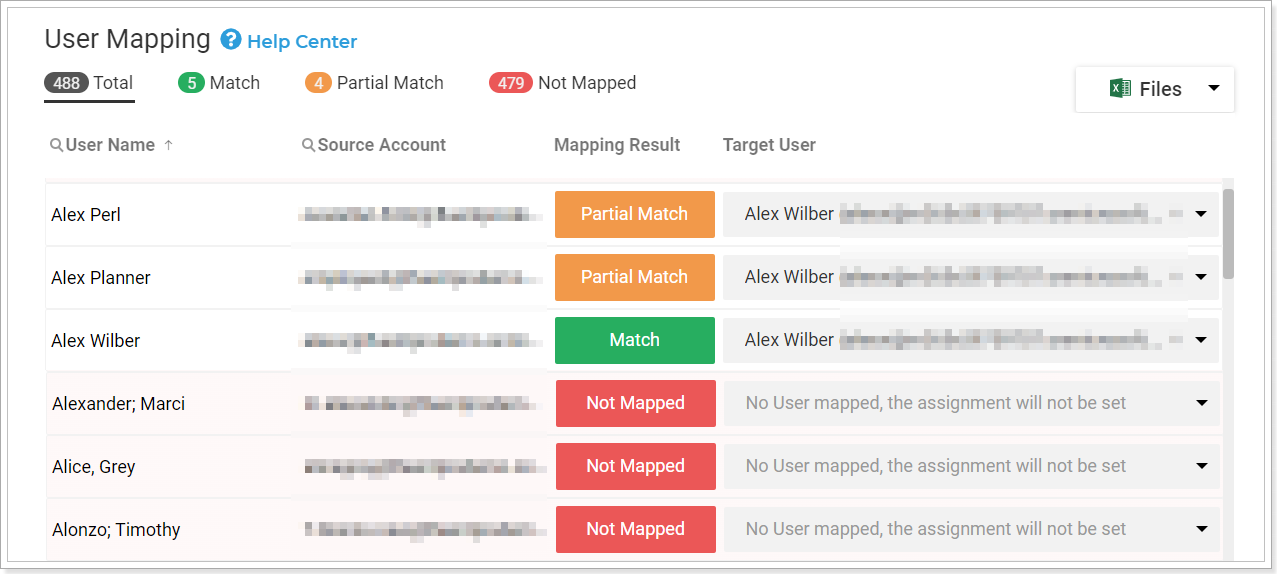
If at least one user is not mapped, a corresponding warning will appear.
Step 4 - Launching the migration process
When you complete all steps: set up the connection between source and target, select data for migration, perform mapping you can launch the migration process.
Please note: Planner Basic sends notifications to all group members about comments, assignments, and when users are added to groups. Because of this, users may receive numerous notifications during data migration to Planner Basic. Please refer to this article to disable them before the migration starts: How to turn off email notifications sent during migrations to Planner Basic.
To launch the migration process click on the Proceed button under the 'User Mapping' section.

Migration Summary window will be opened. Review the information in the Migration Information section and click the 'Start Migration' button to launch the migration process.

Please note: If you have not purchased any subscription plan yet, a free plan (for 2 projects) will be applied. If you have exceeded the limit of projects that you can select for migration according to your subscription plan (free or paid one) and did not upgrade your plan while selecting the projects, you will see the 'Proceed to Checkout' button instead of the 'Start Migration' one. You can upgrade your plan by clicking on this button and then launching the migration process.
Data Migration Summary window will be opened displaying the Summary Information and the progress for the migrated groups and Plans as well as Migration Settings and Mapping.
You can close this window.

The operation details will appear on the Home Page at once in the Migration History section. You can track the migration status here as well.
You can always click on the migration to open the Migration Summary page and review the details for your migration.
Generate Report option allows exporting the migration summary information to an Excel file.
The plans can be opened and reviewed in the target Planner Basic system from the Migration Summary page.

